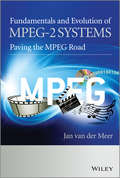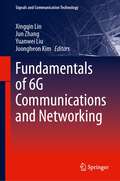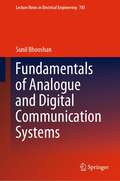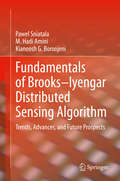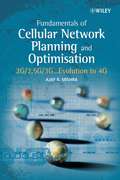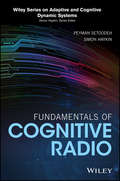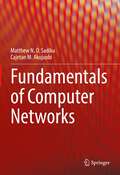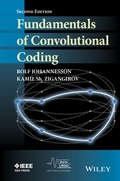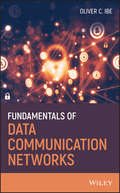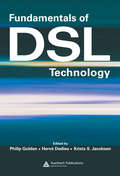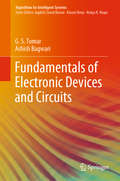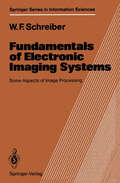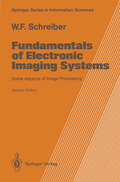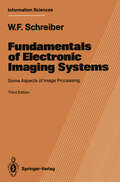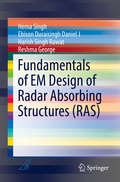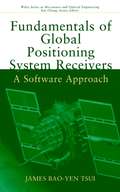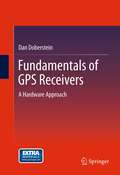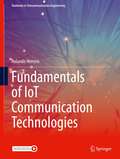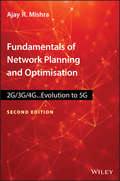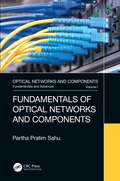- Table View
- List View
Fundamentals and Evolution of MPEG-2 Systems: Paving the MPEG Road
by Jan Van der MeerThis book describes the fundamentals and details of MPEG-2 Systems technology Written by an expert in the field, this book examines the MPEG-2 system specification as developed in the early 1990’s, as well as its evolution into the fourth edition of the MPEG-2 systems standard, published in 2013. While MPEG-2 systems will continue to evolve further, this book describes the MPEG-2 system functionality as of October 2013. Furthermore, relevant background information is provided. The discussion of MPEG-2 system functionality requires knowledge of various fundamental issues, such as timing, and supported content formats. Therefore also some basic information on video and audio coding is provided, including their evolution. Also other content formats supported in MPEG-2 systems are described, as far as needed to understand MPEG-2 systems. Ordered logically working from the basics and background through to the details and fundamentals of MPEG-2 transport streams and program streams Explores important issues within the standardization process itself Puts the developments on MPEG-2 systems into historic perspective Includes support of 3D Video and transport of AVC, SVC and MVC Concludes with additional issues such as real-time interface, delivery over IP networks and usage by application standardization bodies Predicts a continuing promising future for MPEG-2 transport streams
Fundamentals of 6G Communications and Networking (Signals and Communication Technology)
by Xingqin Lin Jun Zhang Yuanwei Liu Joongheon KimThis book begins with a historical overview of the evolution of mobile technologies and addresses two key questions: why do we need 6G? and what will 6G be? The remaining chapters of this book are organized into three parts: Part I covers the foundation of an end-to-end 6G system by presenting 6G vision, driving forces, key performance indicators, and societal requirements on digital inclusion, sustainability, and intelligence. Part II presents key radio technology components for the 6G communications to deliver extreme performance, including new radio access technologies at high frequencies, joint communications and sensing, AI-driven air interface, among others. Part III describes key enablers for intelligent 6G networking, including network disaggregation, edge computing, data-driven management and orchestration, network security and trustworthiness, among others. This book is relevant to researchers, professionals, and academics working in 5G/6G and beyond.
Fundamentals of Analogue and Digital Communication Systems (Lecture Notes in Electrical Engineering #785)
by Sunil BhooshanThe book covers fundamentals and basics of engineering communication theory. It presents right mix of explanation of mathematics (theory) and explanation. The book discusses both analogue communication and digital communication in details. It covers the subject of ‘classical’ engineering communication starting from the very basics of the subject to the beginning of more advanced areas. It also covers all the basic mathematics which is required to read the text. It covers a two semester course as an undergraduate text and some topics in master’s course as well.
Fundamentals of Brooks–Iyengar Distributed Sensing Algorithm: Trends, Advances, and Future Prospects
by Kianoosh G. Boroojeni M. Hadi Amini Pawel SniatalaThis book provides a comprehensive analysis of Brooks-Iyengar Distributed Sensing Algorithm, which brings together the power of Byzantine Agreement and sensor fusion in building a fault-tolerant distributed sensor network. The authors analyze its long-term impacts, advances, and future prospects. The book starts by discussing the Brooks-Iyengar algorithm, which has made significant impact since its initial publication in 1996. The authors show how the technique has been applied in many domains such as software reliability, distributed systems and OS development, etc. The book exemplifies how the algorithm has enhanced new real-time features by adding fault-tolerant capabilities for many applications. The authors posit that the Brooks-Iyengar Algorithm will to continue to be used where fault-tolerant solutions are needed in redundancy system scenarios.This book celebrates S.S. Iyengar's accomplishments that led to his 2019 Institute of Electrical and Electronics Engineers' (IEEE) Cybermatics Congress "Test of Time Award" for his work on creating Brooks-Iyengar Algorithm and its impact in advancing modern computing.
Fundamentals of Cellular Network Planning and Optimisation: 2G/2.5G/3G... Evolution to 4G
by Ajay R. Mishra“By 2008, some 2 billion people will be using mobile phones and devices, in many cases to access advanced data services. Against this backdrop, the need for efficient and effective network design will be critical to the success of increasingly complex mobile networks.” Simon Beresford-Wylie (SVP, Nokia Networks) With the complexity of the cellular networks increasing day by day, a deeper understanding of the design and performance of end-to-end cellular networks is required. Moreover, all the types of networks from 2G-2.5G-3G seem to co-exist. Fundamentals of Cellular Network Planning and Optimisation covers end-to-end network planning and optimisation aspects from second generation GSM to third generation WCDMA networks including GPRS and EDGE networks. All the sub-systems of the network i.e. radio network, transmission network and core network have been covered with focus on both practical and theoretical issues. By bringing all these concepts under one cover, this book becomes essential reading for the network design engineers working either with cellular service vendors or operators, experts/scientists working on end-to-end issues and undergraduate/post-graduate students. Key Highlights: Distinctly divided into four parts: 2G (GSM), 2.5G (GPRS & EDGE), 3G (WCDMA) and introduction to 4G (OFDM, ALL-IP, WLAN Overview) respectively Each part focuses on the radio, transmission and core networks. Concentrates on cellular network planning process and explains the underlying principles behind the planning and optimizing of the cellular networks. The text will serve as a handbook for anyone engaged in the study, design, deployment and business of cellular networks.
Fundamentals of Cognitive Radio (Adaptive and Cognitive Dynamic Systems: Signal Processing, Learning, Communications and Control)
by Peyman Setoodeh Simon HaykinA comprehensive treatment of cognitive radio networks and the specialized techniques used to improve wireless communications The human brain, as exemplified by cognitive radar, cognitive radio, and cognitive computing, inspires the field of Cognitive Dynamic Systems. In particular, cognitive radio is growing at an exponential rate. Fundamentals of Cognitive Radio details different aspects of the human brain and provides examples of how it can be mimicked by cognitive dynamic systems. The text offers a communication-theoretic background, including information on resource allocation in wireless networks and the concept of robustness. The authors provide a thorough mathematical background with data on game theory, variational inequalities, and projected dynamic systems. They then delve more deeply into resource allocation in cognitive radio networks. The text investigates the dynamics of cognitive radio networks from the perspectives of information theory, optimization, and control theory. It also provides a vision for the new world of wireless communications by integration of cellular and cognitive radio networks. This groundbreaking book: Shows how wireless communication systems increasingly use cognition to enhance their networks Explores how cognitive radio networks can be viewed as spectrum supply chain networks Derives analytic models for two complementary regimes for spectrum sharing (open-access and market-driven) to study both equilibrium and disequilibrium behaviors of networks Studies cognitive heterogeneous networks with emphasis on economic provisioning for resource sharing Introduces a framework that addresses the issue of spectrum sharing across licensed and unlicensed bands aimed for Pareto optimality Written for students of cognition, communication engineers, telecommunications professionals, and others, Fundamentals of Cognitive Radio offers a new generation of ideas and provides a fresh way of thinking about cognitive techniques in order to improve radio networks.
Fundamentals of Cognitive Radio (Adaptive and Cognitive Dynamic Systems: Signal Processing, Learning, Communications and Control)
by Peyman Setoodeh Simon HaykinA comprehensive treatment of cognitive radio networks and the specialized techniques used to improve wireless communications The human brain, as exemplified by cognitive radar, cognitive radio, and cognitive computing, inspires the field of Cognitive Dynamic Systems. In particular, cognitive radio is growing at an exponential rate. Fundamentals of Cognitive Radio details different aspects of the human brain and provides examples of how it can be mimicked by cognitive dynamic systems. The text offers a communication-theoretic background, including information on resource allocation in wireless networks and the concept of robustness. The authors provide a thorough mathematical background with data on game theory, variational inequalities, and projected dynamic systems. They then delve more deeply into resource allocation in cognitive radio networks. The text investigates the dynamics of cognitive radio networks from the perspectives of information theory, optimization, and control theory. It also provides a vision for the new world of wireless communications by integration of cellular and cognitive radio networks. This groundbreaking book: Shows how wireless communication systems increasingly use cognition to enhance their networks Explores how cognitive radio networks can be viewed as spectrum supply chain networks Derives analytic models for two complementary regimes for spectrum sharing (open-access and market-driven) to study both equilibrium and disequilibrium behaviors of networks Studies cognitive heterogeneous networks with emphasis on economic provisioning for resource sharing Introduces a framework that addresses the issue of spectrum sharing across licensed and unlicensed bands aimed for Pareto optimality Written for students of cognition, communication engineers, telecommunications professionals, and others, Fundamentals of Cognitive Radio offers a new generation of ideas and provides a fresh way of thinking about cognitive techniques in order to improve radio networks.
Fundamentals of Computer Networks
by Matthew N. Sadiku Cajetan M. AkujuobiThis textbook presents computer networks to electrical and computer engineering students in a manner that is clearer, more interesting, and easier to understand than other texts. All principles are presented in a lucid, logical, step-by-step manner. As much as possible, the authors avoid wordiness and giving too much detail that could hide concepts and impede overall understanding of the material. Ten review questions in the form of multiple-choice objective items are provided at the end of each chapter with answers. The review questions are intended to cover the little “tricks” which the examples and end-of-chapter problems may not cover. They serve as a self-test device and help students determine how well they have mastered the chapter.
Fundamentals of Convolutional Coding (IEEE Series on Digital & Mobile Communication)
by Rolf Johannesson Kamil Sh. ZigangirovFundamentals of Convolutional Coding, Second Edition, regarded as a bible of convolutional coding brings you a clear and comprehensive discussion of the basic principles of this field Two new chapters on low-density parity-check (LDPC) convolutional codes and iterative coding Viterbi, BCJR, BEAST, list, and sequential decoding of convolutional codes Distance properties of convolutional codes Includes a downloadable solutions manual
Fundamentals of Convolutional Coding (IEEE Series on Digital & Mobile Communication)
by Rolf Johannesson Kamil Sh. ZigangirovFundamentals of Convolutional Coding, Second Edition, regarded as a bible of convolutional coding brings you a clear and comprehensive discussion of the basic principles of this field Two new chapters on low-density parity-check (LDPC) convolutional codes and iterative coding Viterbi, BCJR, BEAST, list, and sequential decoding of convolutional codes Distance properties of convolutional codes Includes a downloadable solutions manual
Fundamentals of Data Communication Networks
by Oliver C. IbeWhat every electrical engineering student and technical professional needs to know about data exchange across networks While most electrical engineering students learn how the individual components that make up data communication technologies work, they rarely learn how the parts work together in complete data communication networks. In part, this is due to the fact that until now there have been no texts on data communication networking written for undergraduate electrical engineering students. Based on the author’s years of classroom experience, Fundamentals of Data Communication Networks fills that gap in the pedagogical literature, providing readers with a much-needed overview of all relevant aspects of data communication networking, addressed from the perspective of the various technologies involved. The demand for information exchange in networks continues to grow at a staggering rate, and that demand will continue to mount exponentially as the number of interconnected IoT-enabled devices grows to an expected twenty-six billion by the year 2020. Never has it been more urgent for engineering students to understand the fundamental science and technology behind data communication, and this book, the first of its kind, gives them that understanding. To achieve this goal, the book: Combines signal theory, data protocols, and wireless networking concepts into one text Explores the full range of issues that affect common processes such as media downloads and online games Addresses services for the network layer, the transport layer, and the application layer Investigates multiple access schemes and local area networks with coverage of services for the physical layer and the data link layer Describes mobile communication networks and critical issues in network security Includes problem sets in each chapter to test and fine-tune readers’ understanding Fundamentals of Data Communication Networks is a must-read for advanced undergraduates and graduate students in electrical and computer engineering. It is also a valuable working resource for researchers, electrical engineers, and technical professionals.
Fundamentals of Data Communication Networks
by Oliver C. IbeWhat every electrical engineering student and technical professional needs to know about data exchange across networks While most electrical engineering students learn how the individual components that make up data communication technologies work, they rarely learn how the parts work together in complete data communication networks. In part, this is due to the fact that until now there have been no texts on data communication networking written for undergraduate electrical engineering students. Based on the author’s years of classroom experience, Fundamentals of Data Communication Networks fills that gap in the pedagogical literature, providing readers with a much-needed overview of all relevant aspects of data communication networking, addressed from the perspective of the various technologies involved. The demand for information exchange in networks continues to grow at a staggering rate, and that demand will continue to mount exponentially as the number of interconnected IoT-enabled devices grows to an expected twenty-six billion by the year 2020. Never has it been more urgent for engineering students to understand the fundamental science and technology behind data communication, and this book, the first of its kind, gives them that understanding. To achieve this goal, the book: Combines signal theory, data protocols, and wireless networking concepts into one text Explores the full range of issues that affect common processes such as media downloads and online games Addresses services for the network layer, the transport layer, and the application layer Investigates multiple access schemes and local area networks with coverage of services for the physical layer and the data link layer Describes mobile communication networks and critical issues in network security Includes problem sets in each chapter to test and fine-tune readers’ understanding Fundamentals of Data Communication Networks is a must-read for advanced undergraduates and graduate students in electrical and computer engineering. It is also a valuable working resource for researchers, electrical engineers, and technical professionals.
Fundamentals of DSL Technology
by Hervé Dedieu Krista S. Jacobsen Philip GoldenThe DSL arena is expanding rapidly, making it highly unlikely that any single author can adequately address the breadth and depth of the subject. Responding to the demand of designers worldwide, Fundamentals of DSL Technology combines the strengths of the field's most renowned DSL experts, providing a foundation of all aspects of DSL system design.
Fundamentals of Electronic Devices and Circuits (Algorithms for Intelligent Systems)
by G.S. Tomar Ashish BagwariThis book focuses on conceptual frameworks that are helpful in understanding the basics of electronics – what the feedback system is, the principle of an oscillator, the operational working of an amplifier, and other relevant topics. It also provides an overview of the technologies supporting electronic systems, like OP-AMP, transistor, filter, ICs, and diodes. It consists of seven chapters, written in an easy and understandable language, and featuring relevant block diagrams, circuit diagrams, valuable and interesting solved examples, and important test questions. Further, the book includes up-to-date illustrations, exercises, and numerous worked examples to illustrate the theory and to demonstrate their use in practical designs.
Fundamentals of Electronic Imaging Systems: Some Aspects of Image Processing (Springer Series in Information Sciences #15)
by William F. SchreiberImage processing is an applications area. In this area there are many op portunities to apply art and experience, as well as knowledge from various sciences and engineering disciplines, to the creation of products and pro cesses for which society has urgent need. Without this need, few would be interested in the subject. This point of view motivates this work and has influenced the selection and treatment of topics. It will be noticed that the word "digital" is not in the title. While much of present-day image processing is implemented digitally, this work is not intended for those who think that image processing is a branch of digital signal processing, except perhaps to try to change their minds. This book grew out of courses taught at the Massachusetts Institute of Technology by the author and two of his former students, T.S. Huang and O.J. Tretiak. Like the courses, it is primarily intended for electrical engineers and computer scientists who plan to work in the field. It has not proven necessary to spend much time on strictly digital issues, since the students either know that material already or can learn it very easily by 1 themselves. It also has been unnecessary to be encyclopedic, since Pratt has already performed this important service.
Fundamentals of Electronic Imaging Systems: Some Aspects of Image Processing (Springer Series in Information Sciences #15)
by William F. SchreiberImage processing is a fascinating applications area, not a fundamental science of sufficient generality to warrant studying it for its own sake. In this area, there are many opportunities to apply art and experience, as well as knowledge from a number of sciences and engineering disciplines, to the creation of products and processes for which society has an expressed need. Without this need, work in the field would be sterile, but with it, image processing can readily provide the interested scientist or engineer with a professional lifetime of challenging problems and corresponding rewards. This point of view motivates this book and has influenced the selection and treatment of topics. I have not attempted to 1 be encyclopedic; this service has already been performed by others. It will be noted that the word "digital" is not in the title of this book. While much of present-day image processing is implemented digitally, this work is not intended for those who think of image processing as a branch of digital signal processing, except, perhaps, to try to change their minds. Image gathering and image display, vital parts of the field with strong effects on image quality, are inherently analog, as is image transmission in today's most important medium, the over-the-air broadcasting channel. The latter is not about to die, as it is by far the cheapest way to deliver broadband signals to the home. Likewise, the principal means of recording images on paper are continuous and not discrete.
Fundamentals of Electronic Imaging Systems: Some Aspects of Image Processing (Springer Series in Information Sciences #15)
by William F. SchreiberImage processing is a fascinating applications area, not a fundamental science of sufficient generality to warrant studying it for its own sake. In this area, there are many opportunities to apply art and experience, as well as knowledge from a number of sciences and engineering disciplines, to the creation of products and processes for which society has an expressed need. Without this need, work in the field would be sterile, but with it, image processing can readily provide the interested scientist or engineer with a professioilal lifetime of challenging problems and corresponding rewards. This point of view motivates this book and has influenced the selection and treatment of topics. I have not attempted to 1 be encyclopedic; this service has already been performed by others. It will be noted that the word "digital" is not in the title of this book. While much of present-day image processing is implemented digitally, this work is not intended for those who think of image processing as a branch of digital signal processing, except, perhaps, to try to change their minds. Image gathering and image display, vital parts of the field with strong effects on image quality, are inherently analog, as are all of the channels and media now used, or likely to be used in the future, to record TV signals and to transmit them to the home.
Fundamentals of EM Design of Radar Absorbing Structures (SpringerBriefs in Applied Sciences and Technology)
by Hema Singh Ebison Duraisingh Daniel J Harish Singh Rawat Reshma GeorgeThis book presents a detailed analytical formulation, and step-by-step design procedure for the electromagnetic (EM) design of radar absorbing structures (RAS). It discusses both the equivalent circuit model and Smith chart approach with illustrations to provide a clear understanding of the steps involved in designing multilayered RAS according to the desired specifications. This book is a valuable resource for beginners, academicians, and R&D engineers working in the field of RAS design and development.
Fundamentals of Global Positioning System Receivers: A Software Approach (Wiley Series in Microwave and Optical Engineering #164)
by James Bao-Yen TsuiHow to build and operate GPS receivers-a working resource for engineers While GPS receivers abound in numerous applications, much of the information on their design is scattered in disparate and hard-to-find places. This new work provides engineers who use and design GPS systems with a much-needed comprehensive reference on the operational principles guiding this important technology. With an emphasis on software-based signal processing-a cutting-edge approach expected to dominate future integration of GPS receivers into cellular phones-the book covers all aspects of receiver technology as well as the relevant navigation schemes. Concentrating on civilian C/A code used by commercial GPS receivers (rather than military code), Fundamentals of Global Positioning System Receivers: Describes GPS basics and the constellation of satellites that comprise the GPS system Examines in detail GPS signal structure, acquisition, and tracking Presents the mathematical formulas for calculating a user's position Illustrates the application of important equations using computer programs Explains how to build hardware to collect digitized data for a software GPS receiver Includes a chapter demonstrating a GPS receiver following the signal flow
Fundamentals of GPS Receivers: A Hardware Approach
by Dan DobersteinFundamentals of GPS receivers covers GPS receivers' theory and practice. The book begins with the basics of GPS receivers and moves onward to more advanced material. The book examines three types of GPS receiver implementations: first is the custom design by the author; second is an industry standard design, now part of the open source network; the third relates to the receiver designed by JPL /NASA. Each receiver is unique allowing the reader to see how each design solves the same problems. Chapters discuss carrier phase measurements and GPS time and frequency measurements. The overall text is measurement oriented as opposed to processing the measurements. With a focus on the fundamentals of measurements the reader will be building their intuition for the physical phenomenon at work.
Fundamentals of IoT Communication Technologies (Textbooks in Telecommunication Engineering)
by Rolando HerreroThis textbook explores all of the protocols and technologies essential to IoT communication mechanisms. Geared towards an upper-undergraduate or graduate level class, the book is presented from a perspective of the standard layered architecture with special focus on protocol interaction and functionality. The IoT protocols are presented and classified based on physical, link, network, transport and session/application layer functionality. The author also lets readers understand the impact of the IoT mechanisms on network and device performance with special emphasis on power consumption and computational complexity. Use cases – provided throughout – provide examples of IoT protocol stacks in action. The book is based on the author’s popular class “Fundamentals of IoT” at Northeastern University. The book includes examples throughout and slides for classroom use. Also included is a 'hands-on’ section where the topics discussed as theoretical content are built as stacks in the context of an IoT network emulator so readers can experiment.
Fundamentals of Network Planning and Optimisation 2G/3G/4G: Evolution to 5G
by Ajay R. MishraUpdated new edition covering all aspects of network planning and optimization This welcome new edition provides comprehensive coverage of all aspects of network planning in all the technologies, from 2G to 5G, in radio, transmission and core aspects. Written by leading experts in the field, it serves as a handbook for anyone engaged in the study, design, deployment and business of cellular networks. It increases basic understanding of the currently deployed, and emerging, technologies, and helps to make evolution plans for future networks. The book also provides an overview of the forthcoming technologies that are expected to make an impact in the future, such as 5G. Fundamentals of Cellular Network Planning and Optimization, Second Edition encompasses all the technologies as well as the planning and implementation details that go with them. It covers 2G (GSM, EGPRS), 3G (WCDMA) and 4G (LTE) networks and introduces 5G. The book also looks at all the sub-systems of the network, focusing on both the practical and theoretical issues. Provides comprehensive coverage of the planning aspects of the full range of today's mobile network systems, covering radio access network, circuit and packet switching, signaling, control, and backhaul/Core transmission networks New elements in book include HSPA, Ethernet, 4G/LTE and 5G Covers areas such as Virtualization, IoT, Artificial Intelligence, Spectrum Management and Cloud By bringing all these concepts under one cover, Fundamentals of Cellular Network Planning and Optimization becomes essential reading for network design engineers working with cellular service vendors or operators, experts/scientists working on end-to-end issues, and undergraduate/post-graduate students.
Fundamentals of Network Planning and Optimisation 2G/3G/4G: Evolution to 5G
by Ajay R. MishraUpdated new edition covering all aspects of network planning and optimization This welcome new edition provides comprehensive coverage of all aspects of network planning in all the technologies, from 2G to 5G, in radio, transmission and core aspects. Written by leading experts in the field, it serves as a handbook for anyone engaged in the study, design, deployment and business of cellular networks. It increases basic understanding of the currently deployed, and emerging, technologies, and helps to make evolution plans for future networks. The book also provides an overview of the forthcoming technologies that are expected to make an impact in the future, such as 5G. Fundamentals of Cellular Network Planning and Optimization, Second Edition encompasses all the technologies as well as the planning and implementation details that go with them. It covers 2G (GSM, EGPRS), 3G (WCDMA) and 4G (LTE) networks and introduces 5G. The book also looks at all the sub-systems of the network, focusing on both the practical and theoretical issues. Provides comprehensive coverage of the planning aspects of the full range of today's mobile network systems, covering radio access network, circuit and packet switching, signaling, control, and backhaul/Core transmission networks New elements in book include HSPA, Ethernet, 4G/LTE and 5G Covers areas such as Virtualization, IoT, Artificial Intelligence, Spectrum Management and Cloud By bringing all these concepts under one cover, Fundamentals of Cellular Network Planning and Optimization becomes essential reading for network design engineers working with cellular service vendors or operators, experts/scientists working on end-to-end issues, and undergraduate/post-graduate students.
Fundamentals of Optical Networks and Components
by Partha Pratim SahuThis book is intended as an undergraduate/postgraduate level textbook for courses on high-speed optical networks as well as computer networks. Nine chapters cover the basic principles of the technology and different devices for optical networks, as well as processing of integrated waveguide devices of optical networks using different technologies. It provides students, researchers and practicing engineers with an expert guide to the fundamental concepts, issues and state-of-the-art developments in optical networks. It includes examples throughout all the chapters of the book to aid understanding of basic problems and solutions. Presents basics of the optical network devices and discusses latest developments Includes examples and exercises throughout all the chapters of the book to aid understanding of basic problems and solutions for undergraduate and postgraduate students Discusses different optical network node architectures and their components Includes basic theories and latest developments of hardware devices with their fabrication technologies (such as optical switch, wavelength router, wavelength division multiplexer/demultiplexer and add/drop multiplexer), helpful for researchers to initiate research on this field and to develop research problem-solving capability Reviews fiber-optic networks without WDM and single-hop and multi-hop WDM optical networks P. P. Sahu received his M.Tech. degree from the Indian Institute of Technology Delhi and his Ph.D. degree in engineering from Jadavpur University, India. In 1991, he joined Haryana State Electronics Development Corporation Limited, where he has been engaged in R&D works related to optical fiber components and telecommunication instruments. In 1996, he joined Northeastern Regional Institute of Science and Technology as a faculty member. At present, he is working as a professor in the Department of Electronics and Communication Engineering, Tezpur Central University, India. His field of interest is integrated optic and electronic circuits, wireless and optical communication, clinical instrumentation, green energy, etc. He has received an INSA teacher award (instituted by the highest academic body Indian National Science Academy) for high level of teaching and research. He has published more than 90 papers in peer-reviewed international journals, 60 papers in international conference, and has written five books published by Springer Nature, McGraw-Hill. Dr Sahu is a Fellow of the Optical Society of India, Life Member of Indian Society for Technical Education and Senior Member of the IEEE.
Fundamentals of Optical Networks and Components
by Partha Pratim SahuThis book is intended as an undergraduate/postgraduate level textbook for courses on high-speed optical networks as well as computer networks. Nine chapters cover the basic principles of the technology and different devices for optical networks, as well as processing of integrated waveguide devices of optical networks using different technologies. It provides students, researchers and practicing engineers with an expert guide to the fundamental concepts, issues and state-of-the-art developments in optical networks. It includes examples throughout all the chapters of the book to aid understanding of basic problems and solutions. Presents basics of the optical network devices and discusses latest developments Includes examples and exercises throughout all the chapters of the book to aid understanding of basic problems and solutions for undergraduate and postgraduate students Discusses different optical network node architectures and their components Includes basic theories and latest developments of hardware devices with their fabrication technologies (such as optical switch, wavelength router, wavelength division multiplexer/demultiplexer and add/drop multiplexer), helpful for researchers to initiate research on this field and to develop research problem-solving capability Reviews fiber-optic networks without WDM and single-hop and multi-hop WDM optical networks P. P. Sahu received his M.Tech. degree from the Indian Institute of Technology Delhi and his Ph.D. degree in engineering from Jadavpur University, India. In 1991, he joined Haryana State Electronics Development Corporation Limited, where he has been engaged in R&D works related to optical fiber components and telecommunication instruments. In 1996, he joined Northeastern Regional Institute of Science and Technology as a faculty member. At present, he is working as a professor in the Department of Electronics and Communication Engineering, Tezpur Central University, India. His field of interest is integrated optic and electronic circuits, wireless and optical communication, clinical instrumentation, green energy, etc. He has received an INSA teacher award (instituted by the highest academic body Indian National Science Academy) for high level of teaching and research. He has published more than 90 papers in peer-reviewed international journals, 60 papers in international conference, and has written five books published by Springer Nature, McGraw-Hill. Dr Sahu is a Fellow of the Optical Society of India, Life Member of Indian Society for Technical Education and Senior Member of the IEEE.
